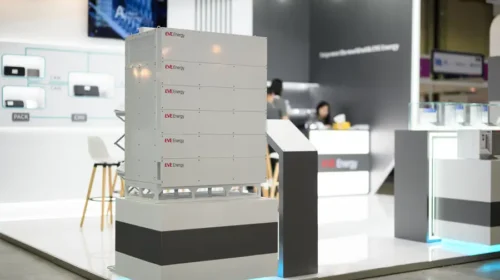Lanvin underperforms as its signature brand loses luster

The luxury arm of Fosun International reported its revenue fell 22% in the first half of 2025, led by a 42% plunge for its core Lanvin brand
Key Takeaways:
- Lanvin Group’s revenue fell 22% in the first half of 2025, as its gross margin fell by four percentage points and its loss widened
- The luxury arm of Fosun International forecast improvement in the second half of the year, following an overhaul that has included store closures and arrival of a new president
By Doug Young
Should Lanvin Group (LANV.US), a collection of global luxury brands owned by China’s Fosun International (0656.HK), consider changing its name?
The company is named for France’s iconic Lanvin brand, arguably one of its most recognized assets and also its biggest breadwinner – until this year. Its latest financial results, released a week ago, show the Lanvin brand is rapidly losing its shine in a global luxury market that is currently struggling. The brand’s sales tumbled 42% year-on-year in the first half of the year to 27.9 million euros ($32.5 million), causing it to sink from its previous spot as the company’s top revenue earner to its third largest.
The company’s “star” performer for the quarter was its U.S.-based St. John brand, owner of St. John Knits, whose revenue only fell 0.8% for the quarter to 39.7 million euros, making it the company’s biggest brand in terms of revenue contribution. Its Wolford division also passed the Lanvin brand during the six-month period, as its revenue fell 23% to 33 million euros.
While we doubt the company will consider changing its name just yet to reflect the evolving contribution from its different brands, Lanvin Group is certainly very much a work in progress. The company was originally called Fosun Fashion Group when it was assembled in the second half of the 2010s through a series of acquisitions by Fosun International. Fosun changed the name to Lanvin Group in October 2021, and listed the company in the U.S. using a special purpose acquisition company (SPAC) at the end of 2022.
The company has struggled ever since, and has experienced high turnover in both its top executive and creative ranks. Most recently, former St. John CEO Andy Lew was named as the company’s executive president at the start of this year. Even before his arrival, the company was engaged in a wide range of cost cutting, including the closure of stores and reductions in its administrative spending, presumably through layoffs. That continued in the first half of this year, as Lanvin Group “streamlined” 29 stores, CFO David Chan said on its earnings call.
Only one analyst currently covers the company, and even that person rates Lanvin as a “hold” – hardly an encouraging sign. What’s more, that analyst didn’t even bother attending the company’s earnings call, which was quite short and consisted only of prepared remarks by Lew and Chan due to lack of analyst participation, according to a transcript of the call.
To be fair, we can’t completely blame the company for all of its woes. The reality is that the global luxury market began to contract last year for the first time since the start of the pandemic, and the downward trend appears to have accelerated this year. Global powerhouse LVMH (MC.PA), owner of the Louis Vuitton brand, reported its revenue fell 4% in the first half of the year, while Gucci owner Kering (KER.PA) said its revenue fell by an even larger 16%.
Revenue decline leader
Lanvin topped both of those big names by reporting its revenue fell 22% year-on-year in the first half of 2025 to 133 million euros, as it blamed “industry-wide softness in the global luxury sector” and its own “strategic repositioning.” The Lanvin brand’s 42% decline was the biggest drag on the company’s revenue, though all of its other brands also posted declines, including the ones we’ve already mentioned for St. John and Wolford, as well as a 25% drop for Sergio Rossi and an 11% for its Caruso brand.
As it struggled, the company’s gross margin slipped by 4 percentage points to 54% in the first half of 2025 from 58% a year earlier, and its adjusted EBITDA loss widened to 52 million euros from 42 million euros.
Geographically, the company said Europe and Greater China were particularly weak during the period. North America, by comparison, was relatively strong, which explains why St. John, which counts the U.S. as its main market, did much better than the other brands.
Fosun had previously hoped to turn its luxury division into a global powerhouse partly by tapping its connections in China, which at the time was the world’s fastest growing luxury market thanks to its red-hot economy. In 2021, a study by Bain-Altagamma projected that China would represent 25% to 27% of the global personal luxury goods market by 2025. But in its 2025 analysis, China represented less than half that amount at 12% of the global market.
Reflecting the China disappointment, the company said Lew is focusing on setting up a second headquarters for Lanvin Group in Europe to complement its base in Shanghai, which is where Fosun is located.
While China has proven to be a disappointment, the company has also suffered due to a revolving door of both executive and creative talent. Lew’s appointment to executive president at the start of the year came as Eric Chan departed from his position as CEO just a little over a year after being appointed to the role. The Lanvin brand also named Peter Copping, a former head of Balenciaga couture, as its new creative director in June last year, filling a position that had been vacant since April 2023.
The company blamed the sharp decline in sales for the Lanvin brand partly on an anticipatory posture from customers eager to see Copping’s first designs, which made their debut at Paris Fashion Week in January this year. It declined to say what impact Copping’s designs are having on the Lanvin brand’s business, but it did forecast that a broader turnaround for the company could take shape in the second half of the year.
“Strategic initiatives already in progress include optimizing the retail footprint, enhancing operational efficiencies, elevating product assortments, launching high-impact marketing campaigns, and strengthening wholesale partnerships,” the company said. “These actions are beginning to deliver encouraging results, with their impact expected to become more pronounced in the second half of the year.”
Lanvin’s stock rallied about 10% in the five trading days after the report came out, though that only returned it to levels from last month. The stock has lost about three-quarters of its value since it completed its SPAC listing in December 2022. It currently trades at a price-to-sales (P/S) ratio of just 0.78, less than half the 1.84 for Kering and a quarter of the 3.14 for LVMH. That seems to show investors remain skeptical of the company’s turnaround story, and want to see actual proof that the business has reached bottom and has started to rebound.
To subscribe to Bamboo Works weekly free newsletter, click here






